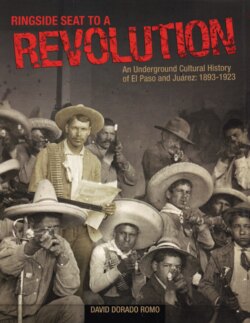Читать книгу Ringside Seat to a Revolution - David Dorado Romo - Страница 16
На сайте Литреса книга снята с продажи.
Оглавлениеpanopticon, a prison in which every single inmate
was under 24-hour surveillance. Foucault argued that
these 18th-century blueprints for a surveillance
machine marked a turning point in the history of the
world and the “economy of power.” The panopticon
is the kind of historical detail you can easily grow an
entire philosophical system out of.
Call it delusions of grandeur, but that is exactly
the kind of detail I was searching for myself—some-
thing that would open up an entire city or era to our
understanding, something with metahistorical, who
knows…even metaphysical implications.
Then again, I would have been happy if I could
just find Pancho Villa.
I FOLLOWED EVERY clue I could, no matter how
insignificant, that might help me find Villa in El Paso
or Juárez.
I wanted to know about Villa’s eating habits: he
loved canned asparagus and could eat a pound of
peanut brittle at a time.
I wanted to know where his offices and headquar-
ters were: the Mills Building, the Toltec and the First
National Bank in El Paso. In Juárez, his headquarters
were in the Customhouse and on Lerdo Street.
How much money he had in the bank on this
side of the line: $2,000,000.
What kind of jewelry his wife wore to high-toned
Sunset Heights tea parties: five diamond rings, a dou-
ble-chained gold necklace with a gold watch and
diamond-studded locket attached, a brooch, a comb
set and earrings with brilliants.
Villa’s musical tastes: he enjoyed “El Corrido de
Tierra Blanca,” “La Marcha de Zacatecas,” “La Adelita”
and “La Cucaracha.”
I TRAVELED THROUGHOUT the United States
and Mexico in pursuit of Pancho Villa. I flew to the
National Archives in College Park, Maryland, where
among other things I pored through the daily reports
of a secret agent in El Paso and examined the 1916
blueprints for the Santa Fe Bridge delousing plant
(where they say Pancho Villa sparked the Bath Riots).
I pursued Villa at the Getty Research Institute in
Los Angeles, a very exclusive place, where thin, pale-
skinned archivists watch your every move closely and
you must always wear white gloves. (How did
Pancho ever end up here?) There I hunted for the
photograph of Ambrose Bierce in El Paso, the old
gringo writer who crossed the border into Juárez in
1914 to join Pancho Villa. “Ah, to be a Gringo in
Mexico—that’s euthanasia!” he wrote a few days
before crossing and was never heard from again. The
photograph, apparently, had also disappeared; it had
been misplaced somehow in the archival collection.
At the Casasola Collection in Pachuca, Mexico,
images of El Paso, Juárez and Villa were everywhere.
There were traces of Villa in Mexico City, in Lubbock,
Texas, and at the Smithsonian Archival Center in
Washington, D.C. Pancho’s letters to Hugh Scott when
Scott was stationed at Fort Bliss were at the Library of
Congress. Reports of his activities were in the munic-
ipal archives of Guerrero, Chihuahua (where one of
the janitors gave me the keys to a closet full of dusty
boxes going back to the 1840s). Clues about Villa
were in Bisbee, Austin, New York, at the Quinta Luz
in Chihuahua, at La Bufa in Zacatecas. There were
even some traces of Villa at the National Library of
Medicine in Bethesda, Maryland, where there were
documents showing that, for the United States, track-
ing down Pancho Villa and tracking down Mexican
germs had become parallel pursuits.
PANCHO VILLA TOOK me to places where I
never expected to go. But although Villa is every-
where in this book, it’s ultimately not about him. He’s
merely my tour guide. Instead Ringside Seat to a
Revolution is about an offbeat collection of individuals
who were in El Paso and Juárez during the revolution.
Many of them crossed Pancho Villa’s path at one time
or another. More often than not, they were both spec-
tators and active participants during one of the most
fascinating periods in the area’s history.
This book is about insurrection from the point of
view of those who official histories have considered
peripheral to the main events—military band musi-
cians who played Verdi operas during executions in
Juárez; filmmakers who came to the border to make
silent flics called The Greaser’s Revenge and Guns and
Greasers; female bullfighters; anarchists; poets; secret
service agents whose job it was to hang out in every
bar on both sides of the line; jazz musicians on
Avenida Juárez during Prohibition when Villa tried to
capture Juárez for a third time; spies with Graflexes;
Anglo pool hustlers reborn as postcard salesmen;
Chinese illegal aliens; radical feminists; arms smugglers;
and, of course, revolutionaries, counterrevolutionaries
and counter-counterrevolutionaries. Ringside Seat to a
Revolution is as much about cultural fermentation as
it is about revolution. It’s about a renaissance born of
conflict.
10
